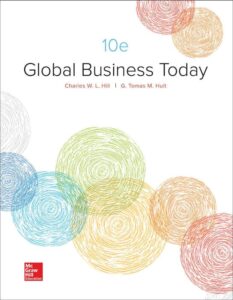Introduction
In today’s globalized world, businesses face fierce competition on a global scale. As technology advances and markets become more interconnected, companies must adapt and compete in the global marketplace in order to survive and thrive. Charles W. L. Hill and G. Tomas M. Hult tackle this topic in their book “International Business: Competing in the Global Marketplace.”
Hill is a renowned scholar and leading author in the field of international business and global strategy. He has published over 50 articles in leading academic journals and authored several textbooks, including “International Business,” which has been translated into more than ten languages. Hult is also an accomplished author and scholar, with over 88 publications in leading academic journals and five books. He is recognized as one of the most influential researchers in the field of international business.
Overview of the Book
“International Business: Competing in the Global Marketplace” is a comprehensive and up-to-date text that covers all aspects of international business, from entry strategies and culture to global finance and marketing. The authors approach the subject from a strategic perspective, emphasizing the importance of understanding the global environment, cultural differences, and international trade policies in order to compete successfully.
The book is divided into four parts. Part One provides an overview of the global business environment and discusses the different methods of entering international markets. Part Two focuses on the internal operations of multinational enterprises (MNEs) and the challenges they face in managing global operations. Part Three covers international trade and investment, including the role of governments and international institutions. Finally, Part Four examines global management challenges, including culture, ethics, and human resource management.
New Edition Features
The tenth edition of “International Business: Competing in the Global Marketplace” includes updated data, examples, and case studies to reflect the rapidly changing global business landscape. The authors have also added a new chapter on international entrepreneurship, which explores the opportunities and challenges faced by small and medium-sized enterprises in international markets.
One of the main features of this edition is its emphasis on real-world examples. The book includes over 40 case studies from a variety of industries and countries, such as the rise of Chinese smartphone maker Xiaomi, the success of Swedish furniture giant IKEA, and the global expansion of South Korean conglomerate Samsung. These case studies provide readers with a practical understanding of how companies compete in the global marketplace.
Key Takeaways
“International Business: Competing in the Global Marketplace” offers valuable insights into the complexities and challenges of international business. The book highlights the importance of understanding cultural differences, adapting to local markets, and developing global strategies in order to succeed in the global marketplace.
In addition, the book provides a solid foundation in international trade and investment, as well as global management challenges. It also offers practical tools and frameworks for analyzing and making strategic decisions in an ever-changing global business environment.
Overall, “International Business: Competing in the Global Marketplace” is an essential read for anyone interested in understanding the dynamics of international business and how to compete successfully in the global marketplace. Whether you are a student, researcher, or business professional, this book will provide you with valuable insights and knowledge to navigate the challenges of the global marketplace.



